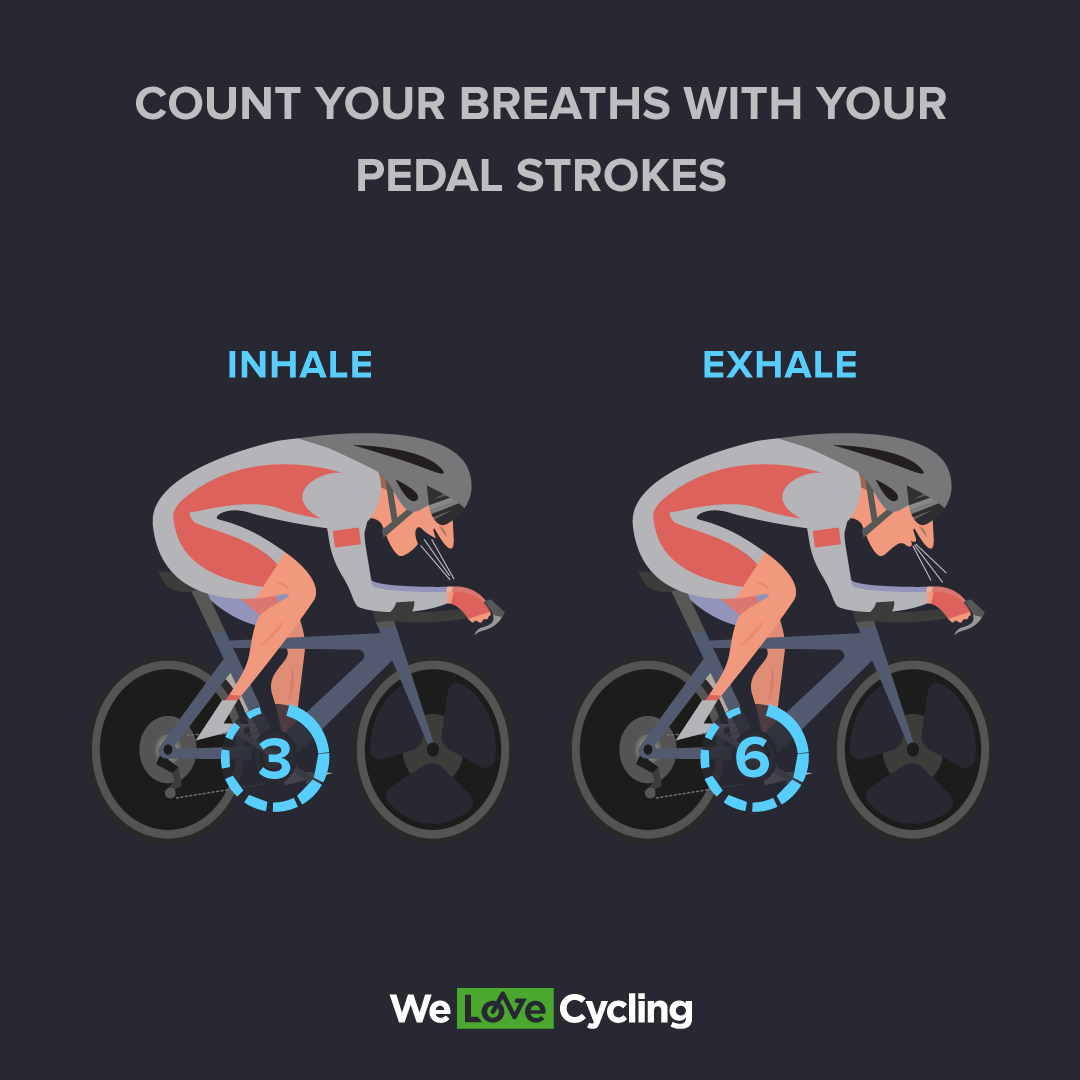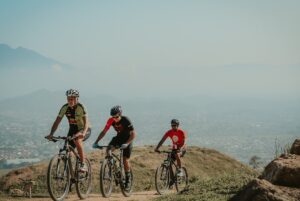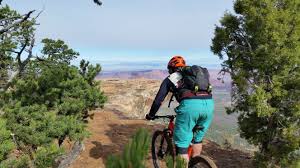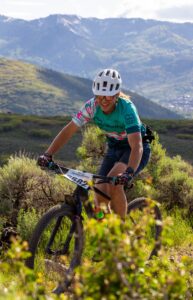Mountain biking isn’t just a thrilling adventure; it’s a full-blown workout for your lungs. Every climb and descent is an opportunity to boost your lung capacity, ensuring that every breath you take is as powerful as the pedals you push. Here’s how you can transform your rides into a lung-strengthening regimen.
Key Takeaways
Mountain biking can significantly improve your lung capacity and overall respiratory health.
Proper breathing techniques are crucial for maximizing oxygen intake during rides.
Engaging your diaphragm and practicing breathing exercises can enhance lung efficiency.
Training for high-altitude rides requires specific acclimatization strategies.
Nutrition and hydration play vital roles in maintaining optimal breathing during cycling.
Breath Power: Maximizing Your Ride
When you’re pedaling up a steep incline, your lungs work overtime to fuel your muscles with oxygen. This isn’t just a workout for your legs; it’s a chance to increase the efficiency of your respiratory system. So, let’s dive into the world of breath power and see how it can take your mountain biking to new heights.
Breathe Strong to Pedal Long
To make the most of your mountain biking experience, you need to focus on your breath. The air you inhale fuels your ride, and the better you breathe, the longer and stronger you’ll pedal. It’s not about gasping for air; it’s about controlled, deep breaths that fill your lungs to capacity.
The Role of Oxygen in Mountain Biking
Oxygen is the magic ingredient that keeps your engine running. When you’re pushing the pedals, your body demands more oxygen to convert glucose into energy. The more efficiently you can get that oxygen into your system, the better your performance will be. For seniors who are enthusiastic about mountain biking, understanding the best techniques and training tips can significantly improve their riding experience.
Understand that your muscles require oxygen to function.
Learn to breathe deeply, not just quickly, to maximize oxygen intake.
Realize that efficient breathing can delay fatigue and improve endurance.
Now, let’s get down to the nitty-gritty of how to actually improve your lung capacity and make every breath count.
Lung Capacity 101
Think of your lungs as balloons. The more air they can hold, the more oxygen is available for your muscles. But unlike balloons, your lungs can be trained to expand their capacity through exercise and technique.
The Science of Strong Lungs
Your lung capacity is the total amount of air that your lungs can hold. Over time, with consistent training, you can increase this capacity. The result? More oxygen coursing through your body to power those tough climbs and sprints. For more detailed insights, check out our senior mountain biking techniques.
How Lungs Fuel Your Cycling
Every time you take a breath, oxygen enters your lungs, passes into your bloodstream, and is carried to your muscles. This oxygen is then used to produce energy. The more efficiently you can breathe, the more energy you’ll have to conquer those trails.
So, how do you train your lungs to be more efficient? By mastering the art of breathing and incorporating specific exercises into your routine.
Techniques to Expand Your Breath
Let’s talk about how you can train your lungs to take in more air and use it more effectively. It’s not just about taking bigger breaths; it’s about making every breath count.

Engage Your Diaphragm
First things first: learn to engage your diaphragm. This muscle is your breathing powerhouse. By breathing from your diaphragm instead of your chest, you’ll draw deeper breaths and improve oxygen exchange.
“Imagine your stomach is a balloon. As you breathe in, fill that balloon with air. As you breathe out, let the balloon deflate naturally. This is how you engage your diaphragm.”
Practice this technique when you’re off the bike, so it becomes second nature when you’re riding. Soon, you’ll find that you can ride longer and harder with less effort.
Stay tuned as we continue to explore more techniques and training tips that will help you breathe your way to the top of the mountain. Remember, your breath is your fuel; let’s make it as efficient as possible.
Training Tips for High-Altitude Rides
Mountain biking at high altitudes is a game-changer for your lungs. The air is thinner, which means less oxygen is available with each breath. To adapt, your body needs to become more efficient at using the oxygen it does get. This is where specific training comes into play.
By preparing for high-altitude rides, you can improve your lung capacity and performance. This doesn’t just happen overnight, though. It takes time, patience, and a well-thought-out training plan.
Remember, acclimatization is key. It’s about giving your body the chance to adjust to the higher elevations gradually. Let’s look at some strategies to help you breathe better when the air is thin.
Acclimatization Strategies
To acclimatize effectively, you should start by gradually increasing your elevation exposure. Spend time at higher altitudes, but don’t overdo it. The idea is to let your body naturally adjust to the decreased oxygen levels.
Start by riding at slightly higher altitudes than you’re used to and progressively increase the elevation over time.
Take rest days to let your body recover and adapt.
Listen to your body. If you’re feeling overly fatigued or experiencing altitude sickness, take it as a sign to slow down.
Remember, acclimatization can’t be rushed. It’s a gradual process that requires your body to make physiological adaptations. Give yourself the time you need to adapt, and your lungs will thank you.
Interval Training for Lung Efficiency
Interval training at your current altitude can also prepare your lungs for the demands of high-altitude biking. By alternating between high-intensity bursts and recovery periods, you’re training your lungs to deal with oxygen debt and recover quickly.
Here’s a simple interval training routine you can try:
Warm up with a gentle ride for about 10 minutes.
Switch to a high-intensity pace for 1-2 minutes, pushing your breathing rate.
Recover with a slow pace for 2-3 minutes, focusing on deep, controlled breaths.
Repeat the high-intensity and recovery intervals for 20-30 minutes.
Cool down with a gentle pace for another 10 minutes.
Consistency is crucial. Aim to include interval training in your routine 2-3 times a week for the best results.

The Relationship Between Cadence and Breathing
When you’re pedaling, your breathing naturally wants to sync up with your cadence. This isn’t just a quirk of human physiology; it’s an opportunity to optimize your breathing during a ride.
Matching Your Breath with Pedal Strokes
Try to establish a rhythm where you inhale over a certain number of pedal strokes and exhale over the next few. For example, you might find that inhaling over two pedal strokes and exhaling over the next two works for you.
Experiment to find a rhythm that feels natural and sustainable. This will help you maintain a consistent flow of oxygen to your muscles and prevent you from becoming breathless.
Regulating Breathing to Maintain Endurance
Regulating your breathing helps to maintain endurance. When you control your breath, you can prevent the panic-breathing that often accompanies tough climbs or sprints.
Focus on maintaining even, deep breaths, even when the going gets tough. This will help you avoid hyperventilation and ensure a steady supply of oxygen to your muscles.
Nutrition and Hydration for Optimal Breathing
What you eat and drink has a direct impact on your breathing. Certain foods can support respiratory health, while staying hydrated ensures that your body can efficiently transport oxygen.
Best Foods to Support Respiratory Health
Include these foods in your diet to support your lung health:
Foods rich in antioxidants, like berries and leafy greens, to protect your lungs from inflammation.
Bananas and potatoes are high in potassium, which helps your muscles and nerves function properly.
Fatty fish, like salmon, provide omega-3 fatty acids that can improve cardiovascular health.
By incorporating these foods into your diet, you’re giving your lungs the nutrients they need to perform at their best. For more tips on maintaining a healthy lifestyle through activities like mountain biking, check out our comprehensive guide.
Staying Hydrated to Stay Oxygenated
Hydration is just as important as nutrition. Water plays a vital role in blood circulation, helping to deliver oxygen throughout your body. Make sure you’re drinking plenty of fluids before, during, and after your rides.
Carry a water bottle or hydration pack with you on your rides, and take sips regularly to maintain hydration levels.
Mountain Biking Gear That Helps
Choosing the right gear can also make a significant difference in your breathing and overall comfort during mountain biking.
Choosing the Right Backpack for Ventilation
When you’re on the trail, a backpack that allows for proper ventilation can prevent your back from getting sweaty, which can make it difficult to breathe. Look for a backpack with a suspended mesh back panel that creates a space for air to flow.
Additionally, make sure your backpack is the right size for your body and the load you’re carrying. An ill-fitting or overly heavy backpack can restrict your breathing and throw off your balance.
Stay tuned for the final part of this series, where we’ll discuss tools to check your lung capacity and answer some frequently asked questions. Remember, the goal is to breathe better so you can ride stronger and longer. Let’s make it happen.
Monitoring your progress is essential to understanding how your lung capacity is improving. It’s not just about feeling less winded on a climb; it’s about having tangible evidence that your lungs are becoming more efficient. Luckily, there are plenty of tools available to help you track your breathing and lung capacity.
Monitoring Progress: Tools to Check Lung Capacity
With the rise of technology, monitoring your lung capacity has never been easier. There are a variety of apps and devices designed to measure your respiratory health and provide feedback on your progress.
Using Apps and Devices to Track Breathing
From wearable fitness trackers to smartphone apps, you can easily keep tabs on your respiratory rate, oxygen levels, and overall lung health. Some devices even offer exercises to improve lung function and track your progress over time.
“Using a smartwatch with a built-in oximeter can give you real-time feedback on your oxygen saturation levels, helping you understand how well your lungs are working during different parts of your ride.”
By regularly checking in with these tools, you can adjust your training as needed and celebrate the improvements in your respiratory health.
Understanding Lung Capacity Metrics
When it comes to lung capacity, there are a few key metrics you should be familiar with. One is the VO2 max, which measures the maximum amount of oxygen your body can use during intense exercise. Another is the tidal volume, which is the amount of air you inhale and exhale with each breath.
By understanding these metrics, you can set specific goals and track your progress towards achieving a greater lung capacity with essential gear tips.
Frequently Asked Questions (FAQ)
As you embark on this journey to increase your lung capacity through mountain biking, you’re bound to have questions. Let’s address some of the most common queries to ensure you’re fully informed and ready to tackle the trails.
How often should I perform breathing exercises?
Can improving lung capacity prevent fatigue on long rides?
Are there benefits to using a breathing trainer?
What’s the best way to breathe while climbing steep hills?
How long does it take to see improvements in lung capacity from training?
How often should I perform breathing exercises?
To see significant improvements, aim to perform breathing exercises daily. Just like any other form of training, consistency is key. Even 5-10 minutes a day can make a big difference over time.
Can improving lung capacity prevent fatigue on long rides?
Yes, absolutely. The more efficiently your lungs work, the more oxygen gets to your muscles, which can delay the onset of fatigue. This means you can enjoy longer rides without feeling as tired.
Are there benefits to using a breathing trainer?
Breathing trainers can be a great addition to your training toolkit. They provide resistance when you breathe in, which can strengthen the muscles involved in respiration and potentially increase lung capacity.
What’s the best way to breathe while climbing steep hills?
When climbing, focus on deep, rhythmic breathing. Try to inhale for a count of three and exhale for a count of three. This can help maintain a steady flow of oxygen to your muscles and prevent breathlessness.
How long does it take to see improvements in lung capacity from training?
Improvements can be seen in as little as a few weeks, but it varies from person to person. It’s important to stay patient and persistent with your training. Over time, you’ll likely notice that you can breathe easier and ride longer without getting winded.
Mountain biking is more than just a sport; it’s a way to challenge your body and breathe life into your lungs. By following these techniques and training tips, you’ll not only increase your lung capacity but also enhance your overall riding experience. Remember, every breath you take is a step towards a stronger, healthier you. Now, hit the trails and breathe deep – the adventure awaits!



Leave a Reply